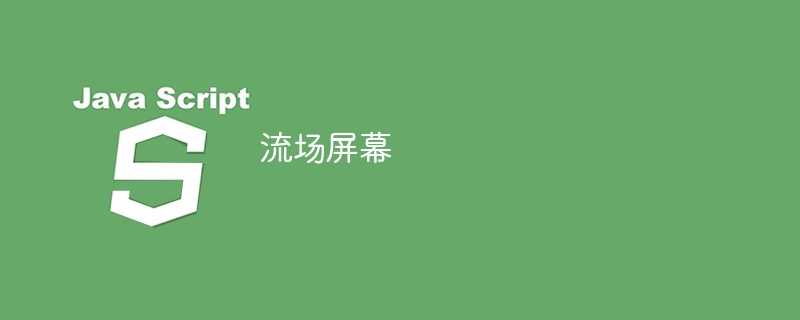流场屏幕
来源:dev.to
时间:2024-10-03 20:45:59 443浏览 收藏
对于一个文章开发者来说,牢固扎实的基础是十分重要的,golang学习网就来带大家一点点的掌握基础知识点。今天本篇文章带大家了解《流场屏幕》,主要介绍了,希望对大家的知识积累有所帮助,快点收藏起来吧,否则需要时就找不到了!

使用 vanilla js 和 html canvas 的动态流场
您是否曾被抽象粒子动画迷住过?这些流动、动态的视觉效果可以通过使用纯 javascript 和 html canvas 元素的极其简单的技术来实现。在本文中,我们将分解创建一个流场的过程,该流场为数千个粒子提供动画,让它们自然运动。
1. 设置项目
首先,我们需要三个文件:一个用于设置画布的 html 文件、一个用于样式设置的 css 文件以及一个用于处理逻辑的 javascript 文件。
<!doctype html>
<html lang="en">
<head>
<meta charset="utf-8">
<meta name="viewport" content="width=device-width, initial-scale=1.0">
<title>flow fields</title>
<link rel="stylesheet" href="styles.css">
</head>
<body>
<canvas id="canvas1"></canvas>
<script src="script.js"></script>
</body>
</html>
解释:
- 我们定义一个
- styles.css 将链接到画布样式。
- 主要动画逻辑包含在 script.js 中。
2. 使用 css 设置画布样式
让我们添加一个简单的样式,为画布提供黑色背景,并确保删除所有内边距和边距。
* {
margin: 0;
padding: 0;
box-sizing: border-box;
}
canvas {
background-color: black;
}
解释:
- 将边距和填充设置为零可确保画布填满整个屏幕。
- 黑色背景与白色颗粒形成良好的对比。
3. 粒子类:创造魔法
particle类是动画的核心所在。每个粒子在画布上移动,留下其过去位置的痕迹,创造出流动的效果。
class particle {
constructor(effect) {
this.effect = effect;
this.x = math.floor(math.random() * this.effect.width);
this.y = math.floor(math.random() * this.effect.height);
this.speedmodifier = math.floor(math.random() * 5 + 1);
this.history = [{ x: this.x, y: this.y }];
this.maxlength = math.floor(math.random() * 200 + 10);
this.timer = this.maxlength * 2;
this.colors = ['#4c026b', '#8e0e00', '#9d0208', '#ba1a1a', '#730d9e'];
this.color = this.colors[math.floor(math.random() * this.colors.length)];
}
draw(context) {
context.beginpath();
context.moveto(this.history[0].x, this.history[0].y);
for (let i = 1; i < this.history.length; i++) {
context.lineto(this.history[i].x, this.history[i].y);
}
context.strokestyle = this.color;
context.stroke();
}
update() {
this.timer--;
if (this.timer >= 1) {
let x = math.floor(this.x / this.effect.cellsize);
let y = math.floor(this.y / this.effect.cellsize);
let index = y * this.effect.cols + x;
let angle = this.effect.flowfield[index];
this.speedx = math.cos(angle);
this.speedy = math.sin(angle);
this.x += this.speedx * this.speedmodifier;
this.y += this.speedy * this.speedmodifier;
this.history.push({ x: this.x, y: this.y });
if (this.history.length > this.maxlength) {
this.history.shift();
}
} else if (this.history.length > 1) {
this.history.shift();
} else {
this.reset();
}
}
reset() {
this.x = math.floor(math.random() * this.effect.width);
this.y = math.floor(math.random() * this.effect.height);
this.history = [{ x: this.x, y: this.y }];
this.timer = this.maxlength * 2;
}
}
解释:
- 构造函数:每个粒子都用随机位置和移动速度初始化。历史数组跟踪过去的位置以创建轨迹。
- draw():该函数根据粒子的历史记录绘制粒子的路径。粒子留下彩色轨迹,增加了视觉效果。
- update():这里,通过计算与流场的角度来更新粒子的位置。速度和方向由三角函数控制。
- reset():当粒子完成其轨迹时,它会重置到新的随机位置。
4.效果类:组织动画
effect 类处理粒子的创建和流场本身,它控制粒子的运动。
class effect {
constructor(canvas) {
this.canvas = canvas;
this.width = this.canvas.width;
this.height = this.canvas.height;
this.particles = [];
this.numberofparticles = 3000;
this.cellsize = 20;
this.flowfield = [];
this.curve = 5;
this.zoom = 0.12;
this.debug = true;
this.init();
}
init() {
this.rows = math.floor(this.height / this.cellsize);
this.cols = math.floor(this.width / this.cellsize);
for (let y = 0; y < this.rows; y++) {
for (let x = 0; x < this.cols; x++) {
let angle = (math.cos(x * this.zoom) + math.sin(y * this.zoom)) * this.curve;
this.flowfield.push(angle);
}
}
for (let i = 0; i < this.numberofparticles; i++) {
this.particles.push(new particle(this));
}
}
drawgrid(context) {
context.save();
context.strokestyle = 'white';
context.linewidth = 0.3;
for (let c = 0; c < this.cols; c++) {
context.beginpath();
context.moveto(c * this.cellsize, 0);
context.lineto(c * this.cellsize, this.height);
context.stroke();
}
for (let r = 0; r < this.rows; r++) {
context.beginpath();
context.moveto(0, r * this.cellsize);
context.lineto(this.width, r * this.cellsize);
context.stroke();
}
context.restore();
}
render(context) {
if (this.debug) this.drawgrid(context);
this.particles.foreach(particle => {
particle.draw(context);
particle.update();
});
}
}
解释:
- 构造函数:初始化画布尺寸、粒子数量、流场。
- init():通过组合每个网格单元的三角函数来计算流场的角度。该场影响粒子的移动方式。
- drawgrid():绘制将画布划分为单元格的网格,调试时使用。
- render():调用每个粒子的绘制和更新方法,以在画布上为粒子设置动画。
5. 通过动画循环让它变得栩栩如生
为了让一切正常工作,我们需要一个动画循环来不断清除画布并重新渲染粒子:
const effect = new Effect(canvas);
function animate() {
ctx.clearRect(0, 0, canvas.width, canvas.height);
effect.render(ctx);
requestAnimationFrame(animate);
}
animate();
解释:
- clearrect():清除每一帧上的画布,以避免覆盖之前的帧。
- requestanimationframe:通过递归调用 animate() 函数来保持动画流畅。
结论
通过分解 particle 和 effect 类,我们仅使用普通 javascript 创建了流体和动态流场动画。 html 画布的简单性与 javascript 的三角函数相结合,使我们能够构建这些令人着迷的视觉效果。
随意使用粒子数、颜色或流场公式来创建您自己的独特效果!
以上就是本文的全部内容了,是否有顺利帮助你解决问题?若是能给你带来学习上的帮助,请大家多多支持golang学习网!更多关于文章的相关知识,也可关注golang学习网公众号。
-
502 收藏
-
501 收藏
-
501 收藏
-
501 收藏
-
501 收藏
-
189 收藏
-
309 收藏
-
154 收藏
-
125 收藏
-
353 收藏
-
208 收藏
-
175 收藏
-
236 收藏
-
489 收藏
-
403 收藏
-
123 收藏
-
171 收藏
-

- 前端进阶之JavaScript设计模式
- 设计模式是开发人员在软件开发过程中面临一般问题时的解决方案,代表了最佳的实践。本课程的主打内容包括JS常见设计模式以及具体应用场景,打造一站式知识长龙服务,适合有JS基础的同学学习。
- 立即学习 543次学习
-

- GO语言核心编程课程
- 本课程采用真实案例,全面具体可落地,从理论到实践,一步一步将GO核心编程技术、编程思想、底层实现融会贯通,使学习者贴近时代脉搏,做IT互联网时代的弄潮儿。
- 立即学习 516次学习
-

- 简单聊聊mysql8与网络通信
- 如有问题加微信:Le-studyg;在课程中,我们将首先介绍MySQL8的新特性,包括性能优化、安全增强、新数据类型等,帮助学生快速熟悉MySQL8的最新功能。接着,我们将深入解析MySQL的网络通信机制,包括协议、连接管理、数据传输等,让
- 立即学习 500次学习
-

- JavaScript正则表达式基础与实战
- 在任何一门编程语言中,正则表达式,都是一项重要的知识,它提供了高效的字符串匹配与捕获机制,可以极大的简化程序设计。
- 立即学习 487次学习
-

- 从零制作响应式网站—Grid布局
- 本系列教程将展示从零制作一个假想的网络科技公司官网,分为导航,轮播,关于我们,成功案例,服务流程,团队介绍,数据部分,公司动态,底部信息等内容区块。网站整体采用CSSGrid布局,支持响应式,有流畅过渡和展现动画。
- 立即学习 485次学习
